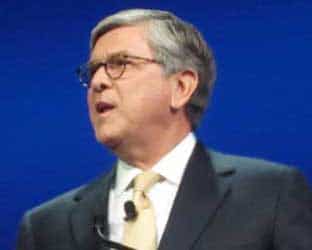LAS VEGAS — If there was one event that could bring together FCC Chairman Ajit Pai, the top leaders of the broadcast television industry and an endless array of exhibitors eager to grow their media tech sales, the 2017 NAB Show now officially underway in Southern Nevada is the definitive draw.
Some 100,000 attendees are here at the Las Vegas Convention Center, with such key executives as Pat LaPlatney, President/CEO of Raycom Media, sharing words with Hilton Howell Jr., President/CEO of Gray Television, at an invitation-only NAB Chairman’s Reception held Sunday evening at the Encore Las Vegas.
Another invite-exclusive event, held this morning at the Las Vegas Country Club, featured an off-the-record conversation with FCC Media bureau Video Division Chief Barbara Kreisman holding court with a room full of media brokers.
But it was astronaut Peggy Whitson and NAB President/CEO Gordon Smith who officially opened the 2017 NAB Show.
The key takeaways: New technologies are bringing AM and FM radio to every device, while “we are witnessing the thrilling innovations taking place” in next-gen television.
In opening remarks, Smith noted that the media landscape “seems to be changing at the blink of an eye, along with the world at large.”
And, these changes can seem both unsettling and exciting, he added.
“Change is a fact of life… except if you’re like comedian Steven Wright who once noted, ‘Change is inevitable, except from vending machines,'” Smith said. “When we talk about broadcasting, it’s very easy to talk about change – both in the way consumers access content and the way broadcasters are delivering it. But there are some things technology will never change: Listeners and viewers will always want that local connection that broadcasters provide – with the weatherman who tells them if a storm is approaching, or with their favorite DJ who warns them of the traffic building up ahead.”
Smith also believes that “the highest-quality content will always find its way to broadcast TV because of its unparalleled reach,” despite the growth of Over-The-Top (OTT) delivery platforms that could one day make ATSC 3.0 an over-hyped technological advance along the same lines as AM Stereo.
While that may be years to come, technology is indeed having a profound effect on media. Yet, Smith opines, “Technology hasn’t changed our commitment to serving our communities.
What has changed is the way we deliver our highly-valued content and services.”
These changes are on display at the Las Vegas Convention Center, across thousands and thousands of square feet full of vendors and exhibitors.
“From mixed reality, to autonomous cars and the future of cinema, we are witnessing the convergence of media, entertainment and technology that is enriching all of our lives,” Smth said. “We face change. We have choices to make. But we must always be guided by our principles.”
This is where Smith elaborated on change.
“Our world is, at the same time, both more connected than ever and more untethered than ever,” he said. “People can access virtually anything from virtually anywhere – and there are millions of sources of information. In addition to radio and TV station broadcasts, Americans also get the information they need from stations’ websites, digital apps and social media pages. The way people access broadcast content is changing rapidly, as we’ve seen with over-the-top, streaming and NextRadio. Many of the challenges and opportunities our industry faces are being driven by new technologies, and primarily the rise of internet protocol – or IP – distribution in its many forms. All of these things are rapidly changing our business.”
This lead Smith to elaborate on choices. He asked, “What do we do in this ever-changing world? We need to believe in the virtuous cycle – the idea that adopting new distribution platforms serves to build our overall audience and engagement with them. And with our core service, we need to embrace our strengths: We are live, local and targeted. We are the most trusted source for news and information for those events that shape the world and our communities. We have a one-to-many architecture that is the envy of other media platforms. In fact, TV stations turned down $38 billion during the recent spectrum incentive auction, choosing to keep their channels, compared to speculators and wireless companies that paid $19 billion for a portion of the TV band.”
To this end, Smith uttered, “I think we now know what the highest and best use of spectrum is.”
While T-Mobile and DISH Network may differ, Smith set the tone for a conference high on technology, with local broadcast media at its core.
“NAB continues to lead the effort to educate U.S. policymakers about the great benefits to viewers in expediting the approval of Next Gen TV,” Smith noted. “Broadcasters have worked tirelessly to promote access to radio receivers in smartphones. Virtually all smartphones are manufactured with hardware capable of receiving free FM radio signals, but not all phones have this feature activated, either by choice of the phone’s manufacturer or the wireless carrier.”
He applauded Sprint, AT&T, T Mobile and Verizon for unlocking FM capability in their Android phones. “We hope our friends at Apple are listening and will soon make this potentially lifesaving technology available to their customers,” Smith said, adding that the “connected car” is another key focus for the NAB in ensuring the continued relevance of radio.
“The choices broadcasters make as we innovate through new technologies must be based on our core principles: Providing a lifeline during emergencies and keeping our communities safe; raising awareness of important health and social issues that impact our lives; providing good jobs and essential information that come from advertising and contribute to our local and national economies; and defending our democratic ideals, the right to speak freely without fear of incrimination, and the right of the press to challenge the government and root out corruption in high places, public or private,” Smith said. “When it comes to defending our core principles, broadcasters are standing as a rock. Broadcasters carry the torch of freedom and integrity, and we must use this to question those in power, to expose those who abuse their positions and to find the truth. Whether it’s the people in charge of our government, or innovations that are changing the way consumers access their content, change is a constant for us. John F. Kennedy said, ‘Change is the law of life. And those who look only to the past or present are certain to miss the future.’ I invite you to join me as we continue to embrace this law of life… and all the future opportunity that comes with it.”
RBR + TVBR





